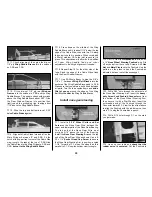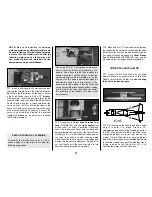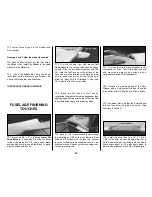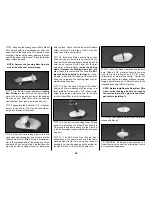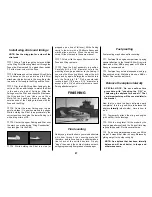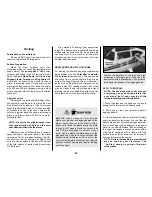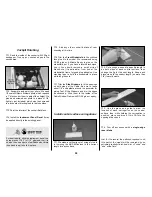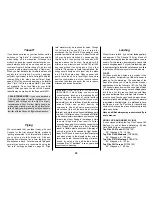
Paints used on the prototype:
We used
K&B Super Poxy primer and color
coat for all plastic and Butyrate parts.
Surface Preparation
Mask the Rear Window
with vinyl
electrician’s tape or Frisket
®
film (available at art
supply stores). Mix
equal parts
of K&B primer,
hardener and thinner, then stir the mixture well.
Spray the
Cowl, Wheel Pants, Tail Cone, Rear
Window Frame, Fairings
and
Wing Struts
with
a
thin
coat of primer. Add a second coat of
primer to areas that need it. Allow primer to dry
overnight before sanding. Wet sand the primer
with 320 and 400-grit sandpaper using a block
where possible. Most of the primer should be
sanded off.
Apply the colors
We sprayed the parts with K&B Super Poxy.
We custom mixed the paint to match the Dark
Red MonoKote by adding a little Yellow and
Black to their standard Red color. Keep a swatch
of MonoKote handy to test and compare the
color on a regular basis. We used a few drops of
Black and Blue mixed with White to match
MonoKote Gray.
NOTE: All paints dry slightly darker than
they appear while wet. Spray on the color
coat when satisfied with the match.
K&B paints are not difficult to use if you have
spray equipment. Use equal parts of the mixed
color paint (Part A) and gloss hardener (Part B),
stir well, then thin the mixture with K&B thinner
so that it can be sprayed. Use about 33 percent
of the total volume of parts A and B combined,
of K&B thinner.
We painted all Landing Gear assemblies
intact. The wheels were masked off with paper
stuffed into the Wheel Pants. By painting the
Landing Gear in this manner, all the par ts
blended together much better than if we had
painted them separately.
DRAW DOOR AND HATCH OUTLINES
For drawing the door and baggage compartment
hatch outlines we used a
Staedtler
®
Lumocolor
313 Permanent
fine point pen. These pens are
available from engineering/drafting supply
stores. We suggest using this pen because it
works well on MonoKote and mistakes can be
removed with 70% rubbing alcohol. Your model
may be cleaned with most cleaners without
affecting the lines too badly. Remember, you can
easily touch-up outlines by using this method.
APPLY THE DECALS
NOTE: The decal sheet does not give you
everything you need to completely trim
your model, but it does provide all the
intricate detailing and difficult items.
1. Study the plans and the photos on the box to
determine the location of individual decals.
2. Thoroughly clean your air plane before
applying decals.
3. Trim the decals as close as practical. Carefully
apply the decals to the model. You can float the
decals into position by first applying soapy water
(two or three drops of dish detergent to a quart of
water) to the model’s surface, then smoothing on
the decal. Squeegee out excess water with a
credit card wrapped with a tissue. Blot the
surface dry and let the decal cure for at least 12
hours before running the engine.
NOTE: Certain text decals are provided and
may be used at your discretion.
The
“No Step” decals go on top of the main
wheel pants.
Position the template on the fuse using the
window as a reference point, then trace the
door outline with a Staedtler pen. You will have
to measure the location of the luggage hatch.
HOT TIP
: Place a sheet of clear butyrate
plastic over the door and luggage hatch on the
plans. Score them onto the plastic with a
hobby knife. Bend the plastic along the score
to break it off cleanly. Sand the corner radii
with 320-grit sandpaper to smooth off any
burrs. Lay the plastic template back over the
plans and use a pen to trace the outline of the
window frame for reference. Cut a hole in the
center of the template so that you can tape it in
position without having any tape extending
over the edges.
Painting
49
Summary of Contents for CESSNA 182 SKYLANE
Page 8: ...8 DIE CUT PATTERNS ...

